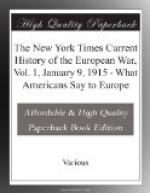“The leaders of our national life had established such a flexible and admirable plan of government that it was soon apparent that each State could retain its identity, forming its own ideals and shaping its own progress, and still remain a loyal part of the whole; that each State could make a place for itself in the new federated nation and not be destroyed thereby.
“There is no reason why each nation in Europe should not make a place for itself in the sun of unity which I am sure is rising there behind the war clouds. Europe’s stupendous economic loss, which already has been appalling and will soon be incalculable, will give us an opportunity to press this argument home.
“True internationalism is not the enemy of the nationalistic principle.
“On the contrary, it helps true nationalism to thrive. The Vermonter is more a Vermonter because he is an American, and there is no reason why Hungary, for example, should not be more than ever before Hungarian after she becomes a member of the United States of Europe.
“Europe, of course, is not without examples of the successful application of the principle of federation within itself. It so happens that the federated State next greatest to our own is the German Empire. It is only forty-three years old, but their federation has been notably successful. So the idea of federation is familiar to German publicists.
“It is familiar, also, to the English, and has lately been pressed there as the probable final solution of the Irish question.
“It has insistently suggested itself as the solution of the Balkan problem.
“In a lesser way it already is represented in the structure of Austria-Hungary.”
America’s Great Work.
“This principle of nation building, of international building through federation, certainly has in it the seeds of the world’s next great development—and we Americans are in a position both to expand the theory and to illustrate the practice. It seems to me that this is the greatest work which America will have to do at the end of this war.
“These are the things which I am writing to my European correspondents in the several belligerent countries by every mail.
“The cataclysm is so awful that it is quite within the bounds of truth to say that on July 31 the curtain went down upon a world which never will be seen again.
“This conflict is the birth-throe of a new European order of things. The man who attempts to judge the future by the old standards or to force the future back to them will be found to be hopelessly out of date. The world will have no use for him. The world has left behind forever the international policies of Palmerston and of Beaconsfield and even those of Bismarck, which were far more powerful.
“When the war ends conditions will be such that a new kind of imagination and a new kind of statesmanship will be required. This war will prove to be the most effective education of 500,000,000 people which possibly could have been thought of, although it is the most costly and most terrible means which could have been chosen. The results of this education will be shown, I think, in the process of general reconstruction which will follow.




